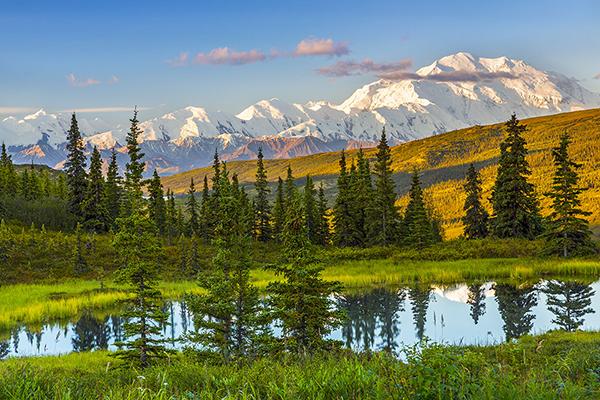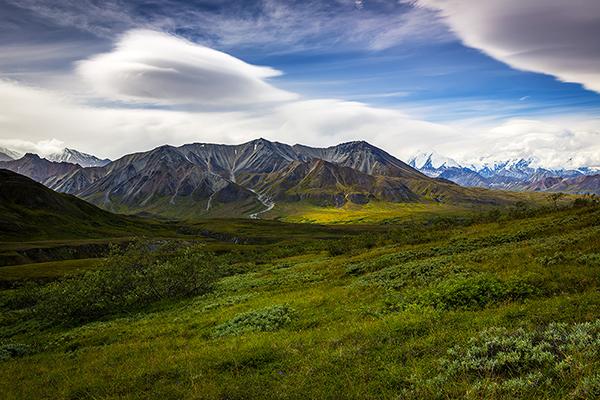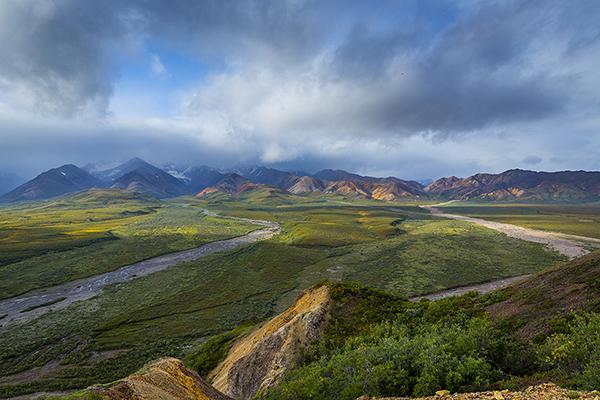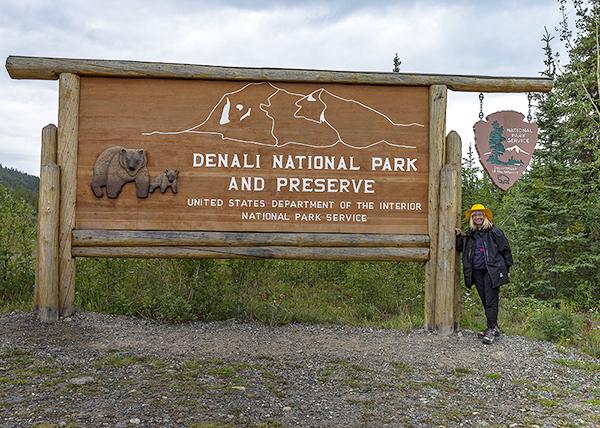
A morning view of Denali at Nugget Pond/Rebecca Latson
Everybody has a bucket list, right? I sure do -- one heckuva large bucket list, as a matter of fact. This past August, I managed to tick off a couple of items from that list. One of them was to spend a few days within Denali National Park and Preserve, Alaska, photographing the late-summer beauty of that place.
The views were incredible. And vast. Mind-blowing, even. The play of light and shadow from the sun and clouds added a touch of the surreal to each composition.

The view near Eielson Visitor Center/Rebecca Latson
In order to capture all of that dramatic play, I (of course) used my two trusty pals: the polarizing filter and the graduated ND (neutral density) filter. And, believe it or not, I used only two lenses: my 24-70mm and 100-400mm.
What? Didn't I use my 16-35mm? I think I used that lens only once. Why? Because the land out there is soooo vast and the mountains so distant, the 16mm perspective would have really placed the mountains further away. There was so much color and drama to the mountains, themselves (especially the ones around Polychrome Pass), I wanted them to be the star of the show and not just some far off background object. Mind you, that is not to say a super wide-angle lens would not produce some astounding images; I've seen a bunch on Flickr. I'm just saying that I did not choose to use the 16-35mm for my own purposes.
There's more than just mountains to photograph out there (although, as I wrote earlier, they *are* the star of the show). There's wildlife (bears, caribou, moose), wildflowers, and the land itself. Ever hiked on tundra? Put your hiking boots on and tromp around on your bed's mattress and you'll get an idea of what it feels like to walk on tundra: a spongy feel with ankle-twisting opportunities if one is not careful. It's a great workout for the legs if you've spent an entire day walking on this stuff.
If you want to photograph within Denali National Park, you should consider the following. You can't just drive your car into the park all the way to the end, you know. According to the Alaska Public Lands Information Centers, you can drive 15 miles into the park using your own vehicle. Or, you can enter the road lottery for a chance to be able to purchase a single, day-long permit that will allow you to drive the length of the park, or as much of the park as weather allows, one long weekend in September.
As a photographer, you can also apply for a special permit through the park's professional photography program, where you can use your own vehicle to drive within the park for 7 days. With this permit, restrictions apply: you must be deriving your main source of income from photography. Otherwise, you will be taking either a flightseeing tour or a bus like the rest of the general public. I took both: a flightseeing tour with Talkeetna Air that included a glacier landing (Eldridge Glacier), and the bus to Camp Denali where I stayed for 4-1/2 days (future Traveler articles ahem).

A bus window view of Polychrome Pass/Rebecca Latson
For either flightseeing or riding in a bus, you might want to think about taking with you a 'fast' camera: a camera that takes a larger number of frames per second (fps) to capture the scene while the bus or plane is moving. You can rent cameras such as Canon 1DX, Nikon D4 or D4s. If that doesn't sound like the thing for you, then set your own camera to Servo (or analogous setting where you can track and focus on moving objects) and apply the 'burst mode' (aka 'spray and pray'): keep your finger down on the shutter button and let it click away. Of course, all the buses going into the park make stops for wildlife and along designated viewing areas. But there may be those times when you simply want to open the bus window while it is driving along and take a photo that way. Then, all of the above applies.
If you've never visited Denali yourself, then by all means, I urge you to add this place to your own bucket list and make every attempt to bring this list item to fruition. Like the scenery in the park, the photographic opportunities are boundless.

At the park entrance/Rebecca Latson



Comments
Rebecca, do you need someone to carry your camera bag as you travel around? If you do, will you please add me to your list of volunteers?
Lee, your name is now at the top of the list ;-)
Stunning, beautiful photos.
Makes me really miss Denali, especially this time of the year, the brief September Fall of about 2 weeks, when the tundra turns the beautiful colors as vivid as Vermont at the height of the season, and all the aspen turn gold, set off by the dark spruce.
Thank you Rebecca Latson. What a fine artist you are.
Rebecca - speaking as an Alaskan resident, thank you ever so much for your wonderfully beautiful documenting of our state.
I hope that one day, Rebecca will take her cameras to the Gates of the Arctic and capture the magic of the Brooks Range. I suspect it is the most beautiful place that I have ever hiked and boated through.
Rick
Thank you for your kind words, d-2. I plan on visiting Denali again in 2-15 during that last week of Aug - first week of Sept. I am hoping that the colors will have changed and I will see that which you describe.
Rick B. you are so welcome, and thank you for your kind words. I fell in love with Alaska when I first visited it in 2013 and have every intention of re-visiting your amazing state next year and hopefully many more years to come.
Rick Smith, the Gates of the Arctic is on my bucket list and I have every intention of making that item come true on my list. Alaska is an amazing place with some incredible parks, scenery and wildlife.